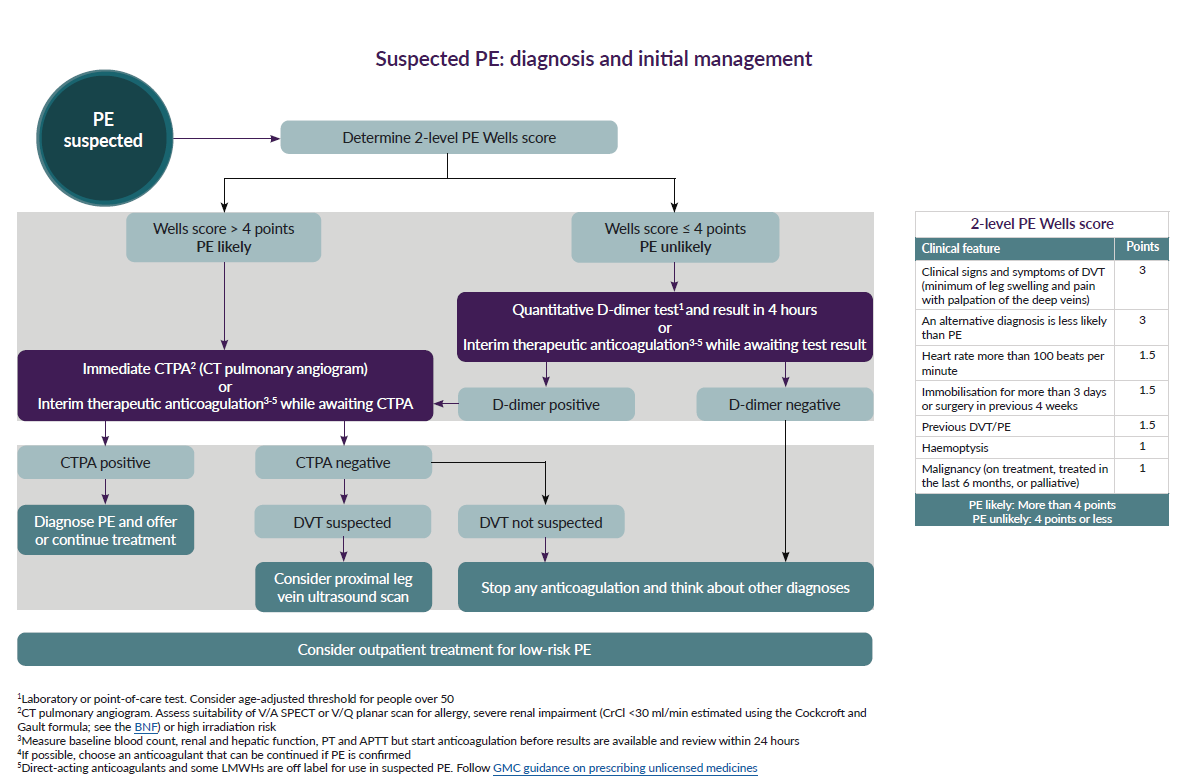PE (pulmonary embolism)
Last edited 05/2020 and last reviewed 09/2023
Pulmonary embolus (PE) occurs when a clot from a vein, originating in the venous sinuses of the calf or the femoral vein or the pelvis, detaches and becomes lodged in the pulmonary arterial tree (1).
Occasionally the right side of the heart is a source of a pulmonary embolus.
Deep vein thrombosis (DVT) is the formation of blood clots in deep veins of the legs (1). In a majority of patients, PE is a consequence of DVT (2)
- when sensitive diagnostic methods were used, DVT was detected in around 70% of patients with PE (2)
- clinically important PEs originate from proximal DVT of the leg e.g. - popliteal, femoral or iliac veins (3)
Venous thromboembolism (VTE) is the term used to describe a thrombus in a vein which may detach from the site of origin and travel through blood to a distant site, a phenomenon called embolism (1). PE and DVT represent different clinical manifestations of VTE (2).
Non thrombotic pulmonary emboli are rare. Causes include:
- septic emboli
- fat emboli
- amniotic fluid
- venous air embolism
- intravascular foreign bodies
- tumor emboli (2)

Reference:
- (1) National Clinical Guideline Centre (NICE) 2010. Venous thromboembolism: reducing the risk of venous thromboembolism (deep vein thrombosis and pulmonary embolism) in patients admitted to hospital.
- (2) Torbicki A et al. Guidelines on the diagnosis and management of acute pulmonary embolism: the Task Force for the Diagnosis and Management of Acute Pulmonary Embolism of the European Society of Cardiology (ESC). Eur Heart J. 2008 ;29(18):2276-315.
- (3) Ramzi DW, Leeper KV. DVT and pulmonary embolism: Part I. Diagnosis. Am Fam Physician. 2004;69(12):2829-36.
- (4)NICE (March 2020). Venous thromboembolic diseases: diagnosis, management and thrombophilia testing
assessment of clinical probability of pulmonary embolism (PE)
severity of pulmonary embolism (PE)
recommendations on the diagnostic investigations to be employed in suspected PE
diagnosis of pulmonary embolism
treatment of pulmonary embolism
risk of recurrence of thromboembolism
thrombophilia screen or screening
flying and reducing the risk of pulmonary embolism (PE)
general advice regarding reducing the risk of venous thromboembolism in surgical patients
cancer and venous thromboembolism (VTE)